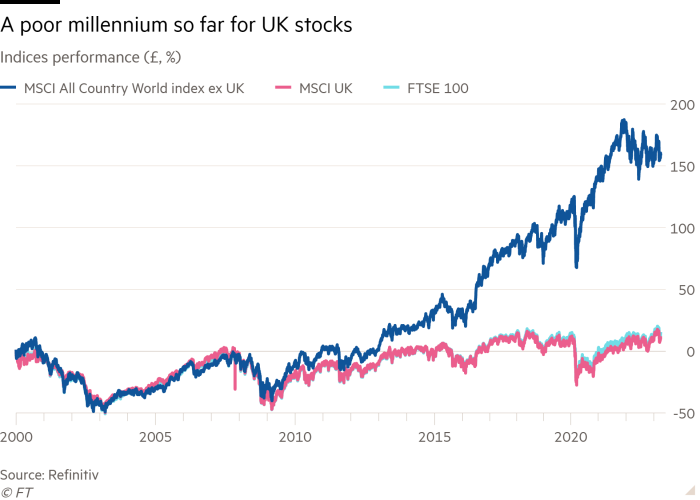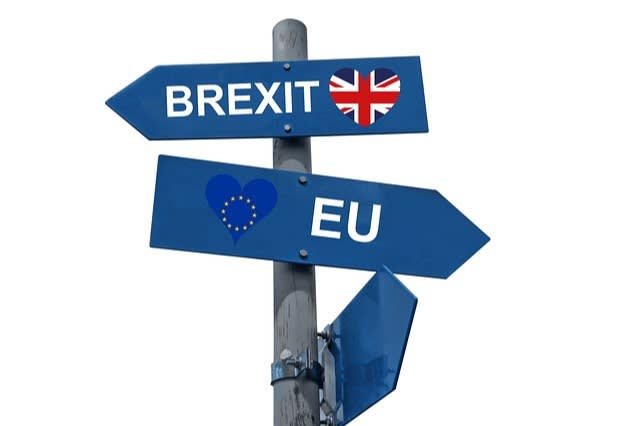
Bliss was it in that dawn to be alive, as Wordsworth wrote. On December 31, 1999, the FTSE 100 index, the benchmark for Britain’s largest quoted companies, closed at 6,930.2, then its highest-ever level. The index had existed only since January 1984, with an initial level of 1,000, so it had risen sevenfold in 15 years. The dotcom boom was in full swing and people had given up their jobs to day trade in equities.
By contrast, the new millennium has proved a shattering disappointment. Remarkably the FTSE 100 index did not pass 7,000 until March 2015 and reached 8,000 only in February this year. At the time of writing, the benchmark was only about 10 per cent higher than at the end of the last millennium. So much for equities always rising over the long term.
Since the start of 2000, Sterling-based investors would have doubled their annual return had they invested in the rest of the world, making 4 per cent, rather than 1.9 per cent in the UK, according to data provided by Paul Marsh of the London Business School.
Those dismal returns have had long-term consequences. The London stock exchange seems to be turning into the “Billy no-mates” of global bourses. Companies can get a much higher valuation if they list elsewhere. Even when the country produces a homegrown technology company, such as Arm, it chooses to list on a US stock exchange, rather than London. And it is not just tech companies that are deserting London; Ferguson, the building products distributor, shifted its listing to New York last year while CRH, the building materials group, announced its intention of doing the same in March.
The London market is not the dominant force in Europe that it used to be; the Amsterdam stock exchange now has a greater volume of trading. At the end of 1999, the UK market represented 9.4 per cent of the FT world Index. Now it is just 4.1 per cent. When the millennium dawned, the London market was valued at more than its nearest European rivals, Paris and Frankfurt, put together; now the continental duo are ahead.
The government has recognised the problem. In December, Jeremy Hunt unveiled the so-called “Edinburgh reforms” aimed at reducing the regulation of the financial sector. “It is important to make sure the industry is competitive,” said Rishi Sunak, the prime minister.
Underperformance can trigger a vicious cycle. Investors lose enthusiasm for the market, which means less liquidity and lower ratings. Lower ratings mean that companies are less willing to stay listed on the market, which delivers another hit to investor enthusiasm.
To add to UK investors’ woes, the immediate economic outlook is not encouraging. The UK is the only country in the Group of Seven leading economies still to have an inflation rate in double digits, while the IMF forecasts that the economy will contract by 0.6 per cent in 2023, a worse performance even than Russia, which has been hit by international sanctions.
So the big question for UK investors is whether it is worth bothering with their home market any more? That includes retail savers, who are offered — and increasingly access — a greater range of overseas investments than ever before.
Alternatively, contrarians might wonder whether, like a dilapidated “fixer-upper” of a house, UK shares might actually turn out to be a bargain? They might not be wrong.
Brexit blues
The roots of the UK stock market’s decline are deep. But one significant element dates back seven years. Brexit was such a divisive issue that many people struggle to assess its economic impact objectively. Still, the financial markets are full of hard-headed profit seekers and their immediate assessment of the vote was to mark down the value of sterling significantly. The pound touched $1.50 just before the referendum result was announced, a level it has never regained; at the time of writing it is just over $1.20. The most plausible reason is that international investors feel that the UK’s economic outlook has deteriorated.
So far that assessment has proved to be correct. The UK was the fastest-growing economy in terms of gross domestic product per head in the G7 between 1980 and 2007, and again between 2010 and 2016. But between 2016 and 2022, it dropped to fifth place out of the seven, behind France, Germany and Italy, all EU members.
Nor is there much good news elsewhere. The corporate sector has also been discouraged by Brexit. Between 2010 and 2016, annual British business investment increased by 40 per cent in real terms. In the following three years, business investment flatlined in real terms before slumping during the pandemic.
Despite generous tax breaks from the government, real investment is still well below pre-referendum levels. Jonathan Haskel, a member of the Bank of England’s monetary policy committee, estimated that the post-Brexit slowdown in business investment has cost the UK 1.3 per cent of GDP.
None of this was surprising. Before 2016, the UK attracted a good share of international investment because it was seen as a politically stable, corporate-friendly and English-speaking base for multinationals within the EU. The country has lost not only the appeal of EU membership but its reputation for political stability, given the recent turnover of prime ministers and chancellors of the exchequer.
1%
Technology companies account for just 1% of the FTSE 100’s market cap
It has not all been bad news. Despite forecasts of a mass exodus of financial services groups after Brexit, London remains the world’s largest centre for both foreign exchange and secondary bond market trading. Nevertheless, investors’ attitudes towards Britain have shifted to the negative. Before the 2016 vote, shares in the UK stock market traded on a similar valuation to those in other developed markets; in the referendum’s aftermath, UK shares fell to a discount which has never been reversed.
Retired hurt
Another cause for the UK market’s decline is longer term; a lack of a domestic investor base. In the last few decades of the 20th century, big domestic pension funds (such as Railpen, the railways scheme) and the insurance companies that managed them (including Standard Life and Scottish Widows) were important market players. They could play a decisive role in takeover bids and act as a constraint on executives on corporate governance issues.
Not any more. The most recent survey by the Office for National Statistics shows that UK pension funds owned just 2 per cent of the UK market, down from 32 per cent in 1992.
The private sector has retreated from offering final-salary pension schemes because of their costs. Also, the remaining schemes have chosen to hedge their risks by switching from equities to fixed income. The bulk of the cost of providing pensions lies in the future, since schemes must pay retirees for 20-30 years. Calculating the cost of those liabilities (and thus how much money pension schemes need to put aside) relies on the level of bond yields. As yields fall, the cost of offering pensions goes up. Pension schemes protect themselves by buying bonds, since the value of their assets then rises in line with their liabilities.
Most employees now have defined contribution (DC) pensions, in which they accumulate a pot to do with as they wish on retirement. Once they have retired, the employer has no further commitment. These DC pension plans tend to have a much higher allocation to equities than the old final-salary schemes.
But in the UK, they are still a small proportion of the pensions market, with just 19 per cent of assets, according to Willis Towers Watson, a consultancy. In the US, where DC pensions have been established for much longer, 65 per cent of pension assets are in DC schemes. As a result, while 33 per cent of overall UK pension fund assets are invested in equities, the proportion of equities in US funds is 56 per cent.

And there is another big difference. The US equity market is much larger than the UK’s; indeed it makes up 58 per cent of the global market, compared with the UK’s 4 per cent. So, little surprise that UK pension funds are more likely to look overseas than their US counterparts.
According to Willis Towers Watson, UK funds devote 40 per cent of their equity allocation to their home market, while the Americans commit 58 per cent. The UK is far from unique in this respect; Canadian pension schemes hold just 19 per cent of their equity portfolios locally.
Deciding on the right proportion of equities to hold in the home market is not easy. In theory, investors build pension funds so they can buy the goods and services needed in their old age. That might suggest a high exposure to the domestic economy. But many goods, including energy, electronic goods and food, are imported.
Furthermore, the UK stock market does not resemble the UK economy. Many of the biggest listed companies are multinational and the market offers little exposure to some of the key services we buy, such as nursing home care. So deciding whether to buy UK shares should be based on valuations, rather than the principle of “home is best”.
Bargain hunting
So what about those valuations? Significantly, the overall climate for equities has recently turned for the worse. Since the 1980s the long-term trend of interest rates and bond yields was down, as inflation was tamed. The effect made equities more attractive in two ways. First, the competing returns on cash and bonds were lower, making equities look like a better bet. Second, just as future pension liabilities cost more at a time of lower rates, so the present value of companies’ future profits increases in value. Low rates also prompted booms in other asset classes such as high-yield bonds, property and cryptocurrencies in what could be dubbed the “great speculative era”.
Britain after Brexit

Keep up to date with the latest developments, post-Brexit, with original weekly insights from our public policy editor Peter Foster and senior FT writers.
Since the start of 2021, these trends have gone into reverse. Russia’s invasion of Ukraine pushed up the headline rate of inflation across the western world and the impact has been longer lasting than expected. Central banks, including the Bank of England, have pushed up their interest rates to levels not seen since before the 2008 financial crisis. Bond yields have shot up. Equities now face more competition from other assets.
The latest sell-off may turn out to be a blip as others have done before it. But it seems doubtful that interest rates and bond yields will again fall to the levels of the 2010s. Government debts are much higher, while globalisation, the force that kept inflation down for much of the past 30 years, is under threat from the geopolitical tensions between the US, Russia and China. The world may have returned to an era when inflation, and interest rates, are as likely to go up as down. This means that equities are unlikely to be the one-way bet they have seemed in the past.
Oddly enough, however, all this bad news might be good for the UK market (in which I have invested via UK equity funds). Savvy investors know that the most relevant issue is whether the news, good or bad, is already in the price. In the late 1990s, investors were right to believe that the internet would change the economy, but wrong to pile money into hundreds of obscure companies with tenuous technological links. The internet turned into a bonanza for just a small group of companies, some of which (Facebook, Google) were not even listed at the time. Just as investors were over-optimistic about the internet in the late 1990s, it is possible they have underestimated the resilience of the UK, still the world’s fifth-largest economy.
Valuations certainly offer some hope. The FTSE 100 index trades on a lowly historic price/earnings ratio of 12.4 and a dividend yield of 3.7 per cent. In other words, savers can get an income that is competitive with most deposit accounts, plus the hope of some capital gain over the long run.
Oddly enough, the dullness of the UK stock market may be an advantage. For much of the past 20 years, ultra-low interest rates have tempted investors into so-called growth stocks. Such companies, usually in technology, may not earn big profits today but are forecast to do so in future. When rates are low, those future profits are valued more highly.
The largest sector of the FTSE 100 is consumer staples, at a little under 20 per cent. This includes such stalwarts as Unilever (with brands such as Domestos, Dove and Lifebuoy), Diageo (Smirnoff and Guinness) and Tesco, the supermarket giant. These may not be fast-growth companies, but they are steady. The second-largest sector is financials which can hardly be described as steady (especially after recent events) but includes the big banks and insurers, and provides a decent level of dividend income — an important consideration for many retail savers. Then comes energy, another source of dividend income. Healthcare and materials round out the top five. Technology accounts for only 1 per cent of the index’s market cap.
The relative cheapness of the UK has attracted private equity buyers, with US groups snapping up the likes of Wm Morrison, the supermarket group and G4S, the security group, in 2021. Late last year one US private equity executive declared: “Everything in the UK is on sale.”
Retail investors may also benefit from a bit of bargain hunting. Equity investing is not always about excitement. It can be about buying shares on reasonable valuations and counting on dividends, plus a bit of profits growth, to offer a decent real return. That can be done via a low-cost equity fund or through an active fund with a “value” bent. In 2023, the outlook is much less rosy than it seemed in 1999. But for that very reason, future returns might be a bit better.
The writer is a financial journalist and author of ‘Surviving the Daily Grind: Bartleby’s Guide to Work’